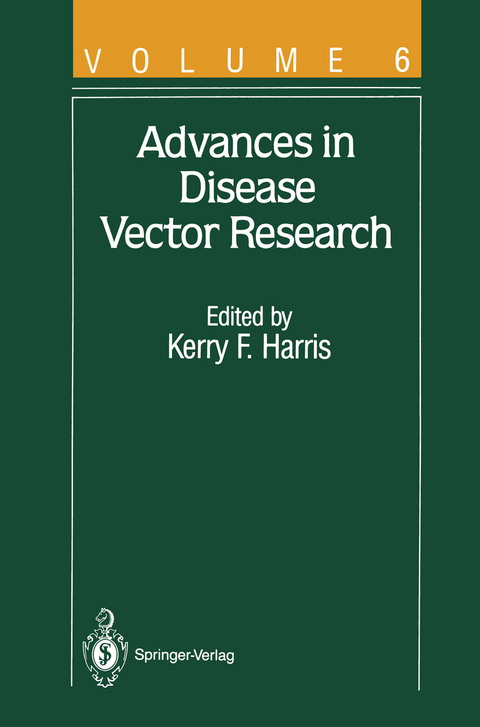
Advances in Disease Vector Research
Springer-Verlag New York Inc.
978-1-4612-7954-9 (ISBN)
1 Ribosomal RNA Genes of the Anopheles gambiae Species Complex.- The Anopheles gambiae Complex.- General Characteristics of Dipteran rDNA.- Anopheles gambiae rDNA: General Structure.- Intergenic Spacer Structure.- Intervening rDNA Sequences.- Applied Uses of rDNA.- Evolution of rDNA Within the Complex.- Summary.- References.- 2 Neuroendocrine and Midgut Endocrine Systems in the Adult Mosquito.- The Nervous System.- The Neuroendocrine System.- The Midgut Endocrine System.- Neuropeptide-Like Immunoreactivity in the Nervous System and Midgut Endocrine System.- Comparison of the Neuroendocrine and Midgut Endocrine Systems.- References.- 3 Gametocytemia and Infectiousness in Falciparum Malaria: Observations and Models.- Gametocytogenesis.- Patterns of Gametocytemia.- Circadian Rhythm.- Infectiousness Versus Gametocytemia.- Reservoir of Infection.- Immune Response.- Gametocytemia and Infectiousness in Mathematical Models of Malaria.- Conclusions.- References.- 4 Some Aspects of the Biology of Phlebotomine Sandfly Vectors.- Colonization.- Sandflies as Reservoirs and Vectors of Viruses.- Age Determination.- Sugar Feeding.- Species Groups and Complexes.- Chemically Mediated Behavior.- References.- 5 Vector-Spirochete Relationships in Louse-Borne and Tick-Borne Borrelioses with Emphasis on Lyme Disease.- The Behavior of Louse-Borne and Tick-Borne Spirochetes in Their Vectors.- The Behavior of Borrelia theileri in Its Tick Vectors.- The Behavior of the Lyme Disease Spirochete Borrelia burgdorferi in Its Tick Vectors.- The Relationship of Borrelia burgdorferi to Nonspecific Tick Vectors and Other Hematophagous Arthropods.- Borrelia burgdorferi: Subject of a Complex Development Cycle?.- Conclusion.- References.- 6 Distribution of Viruses and Their Nematode Vectors.- Nematode-Transmitted Viruses as Plant Pathogens.- Causal Agents.- Vectors.- Virus—Vector Associations.- Discussion.- References.- 7 Detecting Plant Viruses in Their Vectors.- Aphids.- Plant and Leafhoppers.- Nematodes.- Mites.- Fungi.- Beetles.- Other Vector Groups.- Concluding Remarks.- References.- 8 Insect-Borne Viruses of Rice.- Geographical Distribution.- Vector Species.- Vector-Virus Interactions.- Nucleic Acids and Proteins.- References.- 9 Homopteran Transmission of Xylem-Inhabiting Bacteria Alexander.- Historical Background.- Pathogens.- The Xylem Environment.- Vectors.- Epidemiology.- Summary.- References.- 10 Plant Pathogenic Spiroplasmas and Their Leafhopper Vectors.- Spiroplasmas and Their Habitats.- Leafhoppers That Transmit Spiroplasmas.- Transmission Terminology.- Spiroplasma citri.- Spiroplasma kunkelii.- Spiroplasma phoeniceum.- Spiroplasma—Leafhopper Relationships.- Concluding Remarks.- Summary.- References.- 11 Semipersistent Transmission of Viruses by Vectors with Special Emphasis on Citrus Tristeza Virus.- Viruses.- Vectors.- Virus—Vector Relationships.- Epidemiology and Control.- Principles of the Approaches to Control.- Conclusion and Summary.- References.
| Reihe/Serie | Advances in Disease Vector Research ; 6 |
|---|---|
| Co-Autor | S. Barbagallo, M.R. Brown, W. Burgdorfer, F.H. Collins, V. Finnerty |
| Zusatzinfo | XVIII, 363 p. |
| Verlagsort | New York, NY |
| Sprache | englisch |
| Maße | 155 x 235 mm |
| Themenwelt | Medizin / Pharmazie ► Medizinische Fachgebiete ► Mikrobiologie / Infektologie / Reisemedizin |
| Naturwissenschaften ► Biologie ► Mikrobiologie / Immunologie | |
| Naturwissenschaften ► Biologie ► Ökologie / Naturschutz | |
| Naturwissenschaften ► Biologie ► Zoologie | |
| Weitere Fachgebiete ► Land- / Forstwirtschaft / Fischerei | |
| ISBN-10 | 1-4612-7954-2 / 1461279542 |
| ISBN-13 | 978-1-4612-7954-9 / 9781461279549 |
| Zustand | Neuware |
| Haben Sie eine Frage zum Produkt? |
aus dem Bereich


